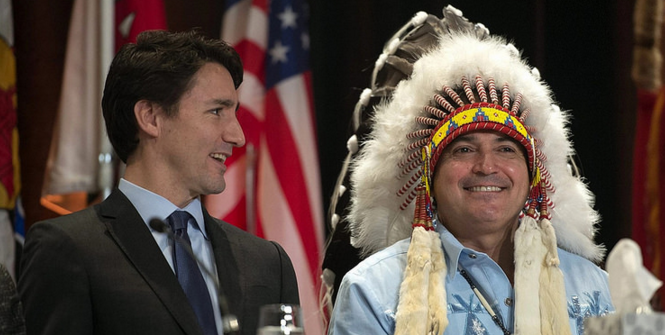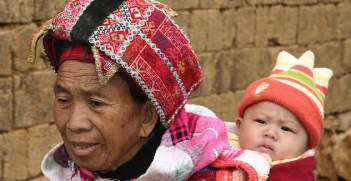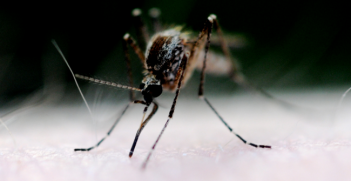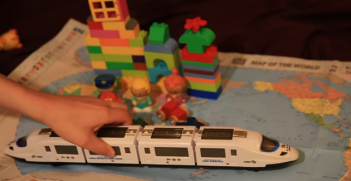Trudeau Launches Canada Into a Radically New Approach to Indigenous Affairs

This Australia Day, Australians will engage in the annual wrestle about the national place of Indigenous people, some even contemplating a referendum on Indigenous constitutional recognition. Meanwhile, Canadians are watching their new government tackle unprecedented reform in Indigenous affairs.
Since his election last October, Prime Minister Justin Trudeau has enjoyed extraordinary media coverage. Much has been superficial: his looks, his family, his father who led Canada for more than a decade. But Trudeau sent deliberate signals throughout the campaign, consciously seeking partners for a new approach to government.
Nowhere was this more evident than in Indigenous affairs. And Trudeau embodies the approach he wants his Liberal government to have.
On his shoulder, Trudeau bears a tattoo designed by Haida artist Robert Davidson. In his public interactions with Indigenous leaders he is unafraid to speak with passion and emotion. His swearing-in ceremony featured a moving performance by young Inuit throat singers.
Much of the enthusiasm should be attributed to the demise of Stephen Harper’s Conservative government. It had alienated Indigenous peoples for more than a decade.
Harper’s first act in Indigenous affairs was to scrap a major social policy accord that would have greatly increased investment in Indigenous housing, education and economic development. Relations reached their nadir in 2012 with the passage of Bill C-38. The legislation radically curtailed protections for Indigenous peoples and the environment to fast-track natural resource developments.
Indigenous peoples and their supporters were galvanised. The result was the political and cultural explosion of Idle No More in late 2012.
More a banner than an organised movement, Idle No More asserted Indigenous sovereignty and called for protection of lands and waters. Mostly young, mostly Indigenous people from all over Canada engaged in hundreds of acts of creative resistance, from teach-ins to flash mob round dances in shopping centres.
What did Trudeau promise?
During the 2015 election campaign, Trudeau made major Indigenous policy commitments. These included a review of all federal laws affecting Indigenous rights. More than C$3 billion in new funding was promised for Indigenous education, including money for infrastructure and post-secondary support for Indigenous students.
A Liberal government would also adopt all the recommendations of the Truth and Reconciliation Commission. That included implementing the UN Declaration on the Rights of Indigenous Peoples. The government would hold a national inquiry into missing and murdered Indigenous women.
In an election with unprecedented participation by Indigenous communities, the Liberals fielded a record 18 Indigenous candidates. Eight of them were elected.
Trudeau then placed two Indigenous people in cabinet portfolios of great importance in Indigenous affairs. Inuk leader Hunter Tootoo became fisheries minister and Kwakwaka’wakw lawyer and activist Jody Wilson-Raybould was appointed justice minister and attorney-general.
In the mandate letters sent to all his ministers, Trudeau insisted:
No relationship is more important to me and to Canada than the one with Indigenous Peoples. It is time for a renewed, nation-to-nation relationship with Indigenous Peoples, based on recognition of rights, respect, co-operation, and partnership.
The reception from Indigenous peoples in Canada, though not universal, has been positive. At the launch of the final report of the Truth and Reconciliation Commission in December, Trudeau was warmly received for adopting all its recommendations. He committed to a ‘new path, working towards a nation-to-nation relationship’ and reiterated key policy commitments in education, justice and reconciliation.
Assembly of First Nations Grand Chief Perry Bellegarde has seized the opportunity for dialogue and collaboration. He called it a ‘new day on Turtle Island‘.
What needs to be done now?
All this rhetoric is matched only by the scale of the tasks ahead. The Truth and Reconciliation Commission report sets these out clearly, framing its 94 “Calls to Action” as responsibilities rather than recommendations.
Quite a few are not aimed at government (but call on universities, law societies, the health professions and the media, among others). But Trudeau will soon need to demonstrate what he understands by a “nation-to-nation” relationship.
Any satisfactory response will involve a hectic legislative agenda. This includes bills on child welfare, primary and secondary education, and Indigenous languages. It will require substantial reform of the criminal justice system, the health system, the public service and cultural policy in Canada, among many other programs and services.
It will require significant investment to support new programs in higher education, healing, training for Indigenous professionals and support for Indigenous businesses, the creation of Indigenous law institutes and appropriate school curricula.
For more than a decade, Indigenous communities and organisations have wanted a national inquiry into missing and murdered Indigenous women. The Royal Canadian Mounted Police recently acknowledged a total of 1181 missing and murdered Indigenous women and girls between 1980 and 2012. This is evidence of a complex problem of racism, poverty and indifference.
Trudeau has directed the ministers of Indigenous and northern affairs, justice and attorney-general and status of women to begin a six-month design process to determine what the inquiry should address and how.
A further explicit commitment is to implement fully the UN Declaration on the Rights of Indigenous Peoples. Taken seriously, this would oblige Canada to abandon its policy of litigation against those Indigenous nations seeking respect for their rights.
Implementing the declaration would also require nothing less than a revolution in the approach to treaty-making and the understanding of “Crown lands”. It would make the Indian Act, which affects nearly every aspect of life on Indigenous reserves, untenable.
The obligation to work on all these matters with Indigenous peoples as national partners on the one hand, and the urgency of demands in areas like housing and education on the other, poses a dilemma for the government. And conflicts over federal and provincial jurisdiction over natural resources and other issues will persist.
Through charisma and his embodiment of generational change, Trudeau is persuading many Indigenous peoples to re-engage with government. But as older Australian readers may recall of Bob Hawke, getting emotional about Indigenous affairs is not enough. A high bar has been set. Indigenous peoples in Canada now expect the new government to meet it.
Ravi de Costa is an Associate Professor of Environmental Studies, York University, Canada. This article originally appeared on The Conversation on 26 January. It is republished with permission.





